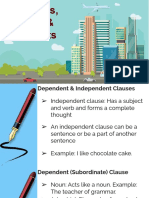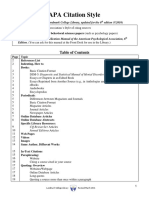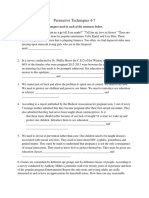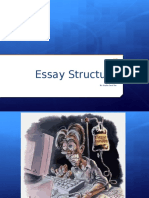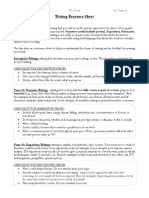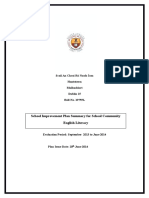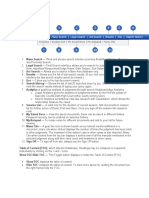APA Handout
APA Handout
Uploaded by
jorsCopyright:
Available Formats
APA Handout
APA Handout
Uploaded by
jorsOriginal Description:
Copyright
Available Formats
Share this document
Did you find this document useful?
Is this content inappropriate?
Copyright:
Available Formats
APA Handout
APA Handout
Uploaded by
jorsCopyright:
Available Formats
APA 6th Edition
Caldwell Community College & Technical Institute
APA Title Page
APA title page format requirements:
A header appears on every page. The words Running head only appear on the first
page.
To insert the header into your paper, go to the second page of your document. Select
insert then page number, top of page and select the first option: plain number 1. Type
your title in ALL CAPITAL LETTERS. Then, hit the tab button two times to get the
page number right aligned.
Go to page one. Click Different First Page under Header & Footer Tools. Type
Running head: then your title in all capital letters. Tab 2 times and type the number 1
Be sure that all information in the header is in a 12-point font to match the text in the
body of your paper.
The title of your paper, your name, and the name of the college belong centered in the
middle of page 1.
Running head: TITLE
The Running head includes the words Running head
with a colon (:). The title of the document, in all capital
letters, belongs after the colon. If the title is long, only
use 50 characters of your title, including spaces and
punctuation.
Note: Some instructors may want
additional information on your title
page like:
Title of Paper
Your Name
Name of College
Title of Paper
Your Name
Course Name/Number
Instructor
Date
Basic Formatting for APA Papers:
1-inch margins
Double spaced
Times New Roman or Arial Font
Last Update: 3/29/16
APA 6th Edition
Caldwell Community College & Technical Institute
Abstract
The abstract is created on a blank page and follows the title page. The page header will still
contain the title of the paper in all capital letters, but Running head: is no longer needed.
Start the page with the word Abstract in the center of the first line. There is no other formatting
required, i.e. bold, italics, or underlining. The body of the abstract will be one double-spaced
paragraph, and it does not need a paragraph indention at the beginning of the paragraph.
The abstract should be a clearly written, 150-250 word summary of the main points in the
research paper. Try to focus on the topic, research, questions encountered, method, results,
conclusion, and, if needed, future research in the paper.
*Not all papers require an abstract. Ask your instructor if this section is needed.
TITLE
2
Abstract
Erik Erikson was a psychologist specializing in neo Freudian studies. Many of his thoughts came from the
Freud way of thinking. A neo Freudian is someone who is influenced by and still practices elements of
Sigmund Freuds psychoanalysis. Erik Eriksons development theory expanded on Freuds five stages of
development, and he later developed an eight stage model of development known as The Life Cycle
Completed. The ego and sexual development are a large focus for Erik Eriksons stages. In each of his
stages there are two main terms for the individual to learn and they are always opposites of each other, i.e.
trust v. mistrust, and autonomy v. shame. Current psychologists and researchers still use Eriksons stages
of development for individual assessments and research is still conducted to prove the validity of Eriksons
design. Eriksons work is important to various areas of psychology especially those dealing with
development and personality.
Last Update: 3/29/16
APA 6th Edition
Caldwell Community College & Technical Institute
Body of Paper
The main body of the APA research paper should begin on a new page following the abstract.
The words Running head no longer appear on each page, but the page number remains in the
upper right corner of the paper. Center the title of your paper on the first line of this page.
Titles
When referring to the title of a work within your paper, capitalize the first word and all
words four letters or more long. (These rules differ on the Reference page.)
Capitalize words under four letters if they are nouns, verbs, pronouns, adjectives, and
adverbs.
Capitalize both words if separated by a hyphen.
Do Not Capitalize:
articles (e.g. a, an, the)
prepositions (e.g. against, between, in, of, to)
coordinating conjunctions (e.g. and, but, for, nor, so, yet)
the to infinitive (i.e. How to Write a Paper)
Italicize titles of books, edited collections, movies, television series, albums, etc.
Ex: The Sound of Music.
One Author
(Johnson, 2009, p. 17).
In-Text Citation Basics
In-text citations consist of authors last name and year of
publication. Include the appropriate page number(s) when
directly quoting.
In-text citations are used throughout your paper when you
are directly quoting, paraphrasing, or summarizing an
authors work.
If there is no author, use the first few words of the title in
quotation marks in the in-text citation.
Last Update: 3/29/16
Two Authors
(Twedel & McDonough, 2009, p. 17).
Three-Five Authors
First citation:
(Yudkin, Brown, & Smith, 2009, p. 17).
All other citations:
(Yudkin et al., 2009, p. 17).
Six or More Authors
(Calhoun et al., 2009, p. 17).
No Author
(Quitting Smoking, 2011, p. 5).
APA 6th Edition
Caldwell Community College & Technical Institute
Short Quotations
When directly quoting from a work, be sure to include the author, year of publication, and page
number in the citation. Begin the quotation with an introductory, or signal, phrase. An
introductory phrase includes the authors name, and/or title of the source. If the authors name is
used within the introductory phrase, follow this phrase with the publication date in parentheses.
If the authors name is not used, the authors last name, the year of publication, and the page
numbers will be placed in parentheses after the quotation.
With authors name in signal phrase:
According to Johnson (2009), eye injuries often occur at work, during recreational activities
and while performing routine household chores (p. 17).
Without authors name in signal phrase:
He says, Its important to wear protective eye-wear, but does not state where to purchase
said eye-wear (Johnson, 2009, p. 17).
Long Quotations
Quotations longer than 40 words will be set up in a block quotation, omitting quotation marks.
To begin, type a signal phrase followed by a colon. The quotation begins on a new line and is
indented one tab button (like a paragraph indention). Block quotes will continue to be double
spaced. (Note: The period will come before the citation in the block form of quotations only).
When speaking of eye protection, Johnson (2009) states the following:
According to the National Institute for Occupational Safety and Health, about 2,000 U.S.
workers suffer job-related eye injuries that require medical treatment each day.
Wearing protective eye gearsuch as goggles, face shields and safety glasses can
reduce the severity of these injuries or even prevent up to 90 percent of them. (p. 17)
Summary or Paraphrase
If you are not directly quoting the work but paraphrasing an idea from the work, you are still
required to cite the source.
o According to Johnson (2009), the eyes exposure to sun can cause the development of
many diseases of the eye.
o The eyes exposure to sun can cause the development of many diseases of the eye
(Johnson, 2009).
Last Update: 3/29/16
APA 6th Edition
Caldwell Community College & Technical Institute
Secondary Sources
When using information quoted from another source, the original source must get credit and the
citation must be provided for the secondary source. For example, you are reading Johnsons
article and in the article, Johnson cites Starnes work. If you want to use Starnes ideas for your
paper, you need to give credit to the original author (Starnes) and where you found the
information (Johnsons article). On the reference page, list Johnsons article in the correct
format. Within the paper, use an introductory phrase, as shown in the example below, to credit
Starnes work; in the citation, use as cited in and the usual citation information. This lets the
reader know the information was from Johnson but originated with Starnes.
Starnes research (as cited in Johnson, 2009, p. 17) shows the benefits of using eye protection.
Works with More than One Author
When a work has two authors, cite both names every time the reference occurs within the text.
Twedel and McDonough (2009) find that the lake is clean (p. 17).
(Twedel & McDonough, 2009, p. 17).
When a work has three, four, and five authors, cite all authors in the first citation and cite only
the first authors name followed by et al. in subsequent citations.
Use as first citation in text
Yudkin, Brown and Smith (2009) say it will be cold (p. 17).
(Yudkin, Brown, & Smith, 2009, p. 17).
Use in subsequent citations
Yudkin et al. (2009) say the ball is round (p. 17).
(Yudkin et al., 2009, p. 17).
When a work has six or more authors, cite only the first authors name followed by et al. in the
first and subsequent citations.
According to Calhoun et al., (2009) flowers irritate allergies (p. 17).
or
(Calhoun et al., 2009, p. 17).
Last Update: 3/29/16
APA 6th Edition
Caldwell Community College & Technical Institute
APA Reference Format Basics
The Reference page belongs in the same document with the rest of the paper. The page
header should be at the top of the page. Center the word References at the top of the page.
Alphabetize entries by the first item, such as the authors last name. If there is no author,
the title will appear first.
The first line of each entry should not be indented; the second, third, fourth, etc. line(s)
should be indented five spaces (or inch). This is called a hanging indentation. See the
examples on the pages which follow.
Only the first word of the title and subtitle, if applicable, is capitalized. This applies to
book and article titles.
Example 1 (book title): How to write a paper
Example 2 (article title): Health education-The case for rehabilitation
The Writing Center has a copy of the 6th edition APA manual for student use. If you have
a source that isnt listed on this guide or have any questions about APA format, please
come by and ask a writing consultant.
Last Update: 3/29/16
APA 6th Edition
Caldwell Community College & Technical Institute
Table of Contents Reference Samples
Author with more than one work ...................................................................................................12
Blog Posting ...................................................................................................................................15
Book(s) .............................................................................................................................................8
Chapter from a Textbook .................................................................................................................9
Electronic Book .............................................................................................................................13
Encyclopedia Entry ..........................................................................................................................9
Government / University Online Document ..................................................................................11
Government Document ....................................................................................................................9
Images ............................................................................................................................................16
Instructor Handout .........................................................................................................................14
Instructor Lecture ...........................................................................................................................14
Interview Personal Communication ............................................................................................14
Online Book (from NCLive) ..........................................................................................................13
Online Encyclopedia or Dictionary ...............................................................................................14
Online Journal Article from Subscription Database (i.e. NCLive) ................................................12
Online Journal Article with DOI....................................................................................................12
Online Magazine Article ................................................................................................................13
Online Newspaper Article..............................................................................................................13
Website Article ..............................................................................................................................11
Last Update: 3/29/16
APA 6th Edition
Caldwell Community College & Technical Institute
Sample APA References: BOOKS
In-Text Citation
Book One Author
(Note: Only the first word in the title should be capitalized, and title of
book goes in italics)
LastName, FirstInitial. MiddleInitial. (Date of Publication). Title of
book (edition [if applicable].). City of Publication, State:
Publisher.
Yudkin, J. M. (2008). Understanding music (5th ed.). Upper Saddle
(Yudkin, 2008, p. 17).
River, NJ: Pearson/Prentice Hall.
BookTwo or More Authors
(Note: Include all authors names up to and including seven authors
[see example one below]. When there are eight or more authors,
include the first six authors names, then insert an ellipsis [], and
add the last authors name [see example two below]).
Example One- work with up to seven authors (list all names):
Yudkin, J. M., Brown, M. L., & Smith, L. K. (2009). Defending the
List all names up to six authors
(Yudkin, Brown & Smith, 2009).
truth. Upper Saddle River, NJ: Pearson/Prentice Hall.
Example Two- work with more eight or more authors:
Weiss, J., Baker, H., Tripp, C., Deal, E.W., Carruthers, E., Thompson,
Use et al. for seven or more
authors
(Weiss et al., 2011).
F., * Harvey, P. (2011). The long, long road from
psychodrama. Middltown, OH: Interesting Books, Inc.
*Implies more authors
names.
Last Update: 3/29/16
APA 6th Edition
Caldwell Community College & Technical Institute
Chapter from a Textbook
(Note: Only the first word of the title of the chapter and the title of the
textbook are capitalized. Always put the word In before the title of
the textbook).
LastName, FirstIntital. MiddleIntital. (Date of Publication). Title of
chapter. In Title of textbook (edition number if applicable and
page numbers). City of Publication, State: Publisher.
Yudkin, J. H. (2008). The nineteenth century: Early romantic music. In
Understanding music (5th ed., pp. 22-55). Upper Saddle River,
NJ: Pearson/Prentice Hall.
Government Document
National Institute of Food Safety. (1999). Clinical training in serious
(Yudkin, 2008, p. 52).
Agency is named in first
citation with abbreviation in
square brackets. Abbreviation
is used in all subsequent
citations.
(National Institute of Food
food borne illness (FDA Publication No. ADM 92-1862).
Safety [NIFS], 1999).
Washington, DC: U.S. Government Printing Office.
(NIFS, 1999).
Encyclopedia Entry
Weinberger, P. G. (2003). Research. In The new encyclopedia
Britannica (Vol. 22, p.101). Chicago, IL: Encyclopedia
Britannica.
Last Update: 3/29/16
(Weinberger, 2003).
APA 6th Edition
Caldwell Community College & Technical Institute
Selection from an Anthology
In-Text Citation
OConnor, F. (2011). A good man is hard to find. In M. Meyer (Ed.),
(OConnor, 2011, p. 451)
The Bedford introduction to literature (pp. 449-459). Boston,
MA: Bedford/St. Martins.
Citing Sacred or Classical Texts
When citing a sacred text or a classical work, a reference entry is not
required. In classical works, cite the year of translation by using trans.
before the year:
(Aristotle, trans. 131)
Many sacred works are segmented by chapters, books, lines, etc., so
use this information as opposed to page numbers when citing sections
of the text. Cite the version in the first citation:
John 3:16 (New International Version)
Sample APA References: ONLINE
(Note: Only the first word of the title of the website needs to be
capitalized. The words Retrieved from go before the URL. There is
no need to write out the entire URL in the citation. Do not include a
period at the end of the entry. Dates of retrieval are only necessary
when citing webpages that are likely to change (e.g. wikis).
Last Update: 3/29/16
10
APA 6th Edition
Caldwell Community College & Technical Institute
In-Text Citation
Website Article
Lastname, FirstInitial. MiddleInitial. (Date of Publication). Title of
webpage. Retrieved from http://www.website.com
Priedt, R. (2015, June 8). Poor sleep? Eating less at night may help.
(Priedt, 2015).
Retrieved from http://www.webmd.com
Website Article No Author
Title of web page. (Date of Publication). Retrieved from
http://www.website.com
AAMI standards philosophy and strategy: Key elements. (2007, June).
(AAMI Standards,
2007).
Retrieved from http://www.aami.org/standards/
philosophy.html
Government / University Online Document
(Note: Organizations and government agencies can be authors as
When used in the in-text
citation, article titles are
enclosed in quotation marks.
If the title is long, you may
shorten it in the in-text
citation.
shown in the sample below.)
Author. (Date of Publication, Creation, or Revision). Title of
document. Retrieved from http://www.website.com
Administration. (2009, October 9). FDA awards $17.5 million
(U.S. Food and Drug
Administration [FDA],
2009).
in grants to further study food and feed safety. Retrieved from
(FDA, 2009).
U.S. Department of Health and Human Services, U.S. Food and Drug
http://www.fda.gov/NewsEvents/Newsroom/
PressAnnouncements/ucm186150.htm
Last Update: 3/29/16
11
APA 6th Edition
Caldwell Community College & Technical Institute
Online Journal Article from Subscription Database (i.e. NCLive)
In-Text Citation
with Volume and Issue
(Note: The title of the journal includes capital letters where
appropriate. This title and the Volume Number are in italics).
LastName, FirstIntital. MiddleIntital. (Date of Publication). Article
title. Journal Name, Volume(Issue Number), Inclusive PageNumbers. Retrieved from http://www.website.com
Twedel, D., & McDonough, M. (2009, August) Treating ventricular
tachycardia. Journal of Continuing Education in Nursing,
(Twedel & McDonough,
2009, p. 342).
40(8), 342-343. Retrieved from http://www.ebscohost.com
Journal Article with DOI
LastName, FirstIntital. MiddleIntital. (Date of Publication). Article
title. Journal Name, Volume(Issue Number), Inclusive PageNumbers. doi: 10.10xx/xxxxxxxxxxxxxxxxxx
Green, J. (2008, December) Health education-The case for
(Green, 2008, p. 448).
rehabilitation. Critical Public Health, 18(4), 447-456. doi:
10.1080/09581590802443596
Author(s) with more than one work
(Note: Prioritize works by year of publication, oldest first; if published
in the same year, assign alphabetic designations (a, b, c) to works in
alphabetic order.).
Example One- Same author, different years of publication:
Hamon, T. (2001). The role of calcium in the diet. Vitamins from
A-Z. 12(9), 12-13. Retrieved from http://website.com
Last Update: 3/29/16
12
(Hamon, 2001, p. 12).
APA 6th Edition
Caldwell Community College & Technical Institute
Hamon, T. (2003). Healthy bones linked to vitamin D. Vitamins from
(Hamon, 2003, p. 241).
A-Z. 14(18), 240 - 245. Retrieved from http://website.com
Example Two- Same author, same year of publication:
Hamon, T. (2003a). Cant get enough vitamin C. Vitamins from A-Z.
(Hamon, 2003a, p. 23).
14 (17), 22-25. Retrieved from http://website.com
Hamon, T. (2003b). Healthy bones linked to vitamin D. Vitamins from
(Hamon, 2003b, p. 12).
A-Z. 14 (18), 12-13. Retrieved from http://website.com
Online Book (from NCLive)
LastName, FirstIntital. MiddleIntital. (Date of Publication). Title of
(Calhoun & Bradley, 1997).
book. Retrieved from http://www.website.com
Calhoun, S., & Bradley, J. (1997). Nutrition, cancer and you: What
you need to know, and where to start. Retrieved from
http://www.netlibrary.com
Electronic Books
Ellsberg, M. (2010). The power of eye contact: Your secret success in
(Ellsberg, 2010, p. 232).
business, love, and life. Retrieved from
http://books.google.com/ebooks?id=XOp86Mf0jY0C&as_brr=
5&source=webstore_bookcard
Online Newspaper Article
Chernow, R. (2009, October 23). Everymans financial meltdown. The
(Chernow, 2009)
New York Times. Retrieved from http://www.ebscohost.com
Online Magazine Article
Klein, J. (2011, August 29). What a win. Time Magazine, 178(8).
Retrieved from http://www.time.com/time/magazines
Last Update: 3/29/16
13
(Klein, 2011)
APA 6th Edition
Caldwell Community College & Technical Institute
Online Encyclopedia or Dictionary
In-text Citation
(Note: If there is an author available, begin with the authors
LastName, FirstInitial, MiddleInitial. If not, begin with the article
title.)
Society. (1993). In Encyclopdia Britannica online. Retrieved from
(Society, 1993).
http://www.britannica.com/society
Other Types of Sources
Interview - Personal Communication
(Note: Personal interviews are not included on the Reference page.
(Matt Williams, personal
They are noted in the text only. Include interviewees name, type and
communication, August 25,
date of interview.)
2011).
Instructor Lecture
LastName, FirstInitial. MiddleInitial. (Year, Month). Title of lecture.
In class lecture, Location.
Benton, L. (2010, November).The Romantic period. In class lecture,
(Benton, 2010).
Caldwell Community College and Technical Institute.
Instructor Handout
LastName, FirstInitial. MiddleInitial. (Year, Month). Title of handout.
Source of handout, Location.
Benton, L. (2010, November). Attributes of the Romantic period.
Course Moodle page, Caldwell Community College and
Technical Institute.
Last Update: 3/29/16
14
(Benton, 2010).
APA 6th Edition
Caldwell Community College & Technical Institute
Blog Posting
In-Text Citation
(Note: Use the authors full name if available; if not, use the screen
name. Use the exact date of the posting.)
LastName, FirstIntital. MiddleIntital. (Year, Month Day). Subject of
the message. [Web log post]. Retrieved from
http://www.website.com
The Jolly Reader. (2011, June 30). A pirate learns to read. [Web log
(The Jolly Reader, 2011).
post]. Retrieved from http://thejollyreader.wordpress.com/
2011/06/30/a-pirate-learns-to-read/
YouTube videos
Author, A. A. [Screen name]. (year, month day). Title of video
[Video file]. Retrieved from http://www.youtube.com
Bio. (2012, September 21). Mini bio Edgar Allan Poe [Video file].
Retrieved from https://www.youtube.com/watch?v=x387NMCR6w
Last Update: 3/29/16
15
(Bio, 2012).
APA 6th Edition
Caldwell Community College & Technical Institute
Images such as photographs, charts and graphs are inserted into the
body of the paper as near the text which discusses the image as
possible. Each image will be labeled as a Figure and citation
information is noted in the figure legend or caption. Using text boxes
will simplify the labeling process.
Figure 1 Cover of APA Publication Manual, 6th Edition
APA publication manual, 6th ed. [Image]. Retrieved from
http://www.bakeru.edu/images/stories/1_Academics/2_Library/citation/apa_6th_ed.gif
Last Update: 3/29/16
16
You might also like
- APA ReviewDocument7 pagesAPA ReviewVanessa100% (2)
- Part A - Developing An Outline For A Persuasive Essay - A Handout For E4Document11 pagesPart A - Developing An Outline For A Persuasive Essay - A Handout For E4Kelly Baidal SantosNo ratings yet
- Expository Writing ChecklistDocument3 pagesExpository Writing Checklistapi-314679553No ratings yet
- Personal Narrative OutlineDocument2 pagesPersonal Narrative OutlineSHANE ANGEL BORBENo ratings yet
- AW1 Workbook 2014Document133 pagesAW1 Workbook 2014jadenNo ratings yet
- Semicolons and Colons PowerpointDocument17 pagesSemicolons and Colons PowerpointcandeceNo ratings yet
- Paraphrasing Quoting SummarizingDocument2 pagesParaphrasing Quoting SummarizingJessel Lusanta MontalbanNo ratings yet
- Types of HooksDocument9 pagesTypes of HooksKendra GaleNo ratings yet
- Thesis StatementDocument36 pagesThesis StatementCresilda BiloyNo ratings yet
- 10h and 10J VOCABULARY ActivityDocument9 pages10h and 10J VOCABULARY ActivityREGINEA SHIRLEYNo ratings yet
- Memo and LetterDocument26 pagesMemo and LetterAbdulaziz KaramiNo ratings yet
- PhrasesDocument80 pagesPhrasesDebuton ChesterNo ratings yet
- Persuasive Technique Used in WritingDocument41 pagesPersuasive Technique Used in Writingtamera dellamore100% (1)
- What You Need To Know About The English ADocument22 pagesWhat You Need To Know About The English Abrittonjuliano3No ratings yet
- CSEC English A - January 2022Document29 pagesCSEC English A - January 2022Danni SinghNo ratings yet
- Dependent and Independent ClausesDocument4 pagesDependent and Independent Clausesnoooooooooonooooooooooooo100% (1)
- Clauses: Independent DependentDocument32 pagesClauses: Independent DependentFabrizioLupoNo ratings yet
- Writing Lesson PlanDocument11 pagesWriting Lesson PlanCarolina OrlandoNo ratings yet
- CSEC June 2021 Qu 2 Mark Scheme ADocument5 pagesCSEC June 2021 Qu 2 Mark Scheme ADalmar RussellNo ratings yet
- Compare and Contrast EssaysDocument18 pagesCompare and Contrast EssaysMaryam AleemNo ratings yet
- Revision Checklist Phase AutobiographyDocument2 pagesRevision Checklist Phase Autobiographyapi-309242995No ratings yet
- How To Write Narrative Text PDFDocument3 pagesHow To Write Narrative Text PDFTUTIKNo ratings yet
- My Parents Kept Me From Children Who Were RoughDocument3 pagesMy Parents Kept Me From Children Who Were RoughTatum MurrNo ratings yet
- APA Citation Guide 6th EdDocument19 pagesAPA Citation Guide 6th EdLautaro MaidanaNo ratings yet
- Writing A SummaryDocument3 pagesWriting A Summaryfreedomone100% (1)
- Summary WritingDocument21 pagesSummary Writingabigail chableNo ratings yet
- Compare and Contrast Peer ReviewDocument2 pagesCompare and Contrast Peer Reviewapi-212361252100% (1)
- Asking Questions in English: Write Questions For The Underlined WordsDocument2 pagesAsking Questions in English: Write Questions For The Underlined WordsFatima VazquezNo ratings yet
- Csec English A Sba GuidelinesDocument29 pagesCsec English A Sba GuidelinesCherrish GittensNo ratings yet
- 01 Expository Writing - Hooks Transitions and ConclusionsDocument14 pages01 Expository Writing - Hooks Transitions and Conclusionsapi-272844766No ratings yet
- ELC501 (2) Context Clues Notes - ODLDocument24 pagesELC501 (2) Context Clues Notes - ODLHamzah AmshahNo ratings yet
- Argumentative Essay TopicsDocument2 pagesArgumentative Essay TopicsAnicaNo ratings yet
- WORDINESS AND GOBBLEDYGOOK Exercises Answer KeyDocument7 pagesWORDINESS AND GOBBLEDYGOOK Exercises Answer KeyChristian VidrihNo ratings yet
- Persuasive Techniques WorksheetDocument2 pagesPersuasive Techniques WorksheetMs-Devashia T WhyteNo ratings yet
- Essay StructureDocument29 pagesEssay Structurelouise carinoNo ratings yet
- English 11 Forms of WritingDocument2 pagesEnglish 11 Forms of Writingapi-266273096No ratings yet
- Argumentative Essay TopicsDocument3 pagesArgumentative Essay TopicsJeramaeNo ratings yet
- Expository Writing: What Is Expository Writing? Types of Expository Writing Example, Non-ExampleDocument10 pagesExpository Writing: What Is Expository Writing? Types of Expository Writing Example, Non-ExampleAhmad AghaNo ratings yet
- Similes and MetaphorsDocument3 pagesSimiles and Metaphorsapi-237886495No ratings yet
- Course Syllabus Aa ReadingDocument9 pagesCourse Syllabus Aa Readingapi-297204727No ratings yet
- Reading and Use of English - STRATEGIESDocument3 pagesReading and Use of English - STRATEGIESSoprano ErickaNo ratings yet
- Mechanics of Writing PunctuationDocument11 pagesMechanics of Writing PunctuationChristopher HernandezNo ratings yet
- Language Paper 1 Revision Guide AQADocument80 pagesLanguage Paper 1 Revision Guide AQAsohailnoreen5062No ratings yet
- Chapter 2Document16 pagesChapter 2Fizza Rauf100% (1)
- How To Write An Argumentative Essay TutorialDocument15 pagesHow To Write An Argumentative Essay Tutorialapi-260860664No ratings yet
- LP Narrative WritingDocument5 pagesLP Narrative WritingMarjorie MalvedaNo ratings yet
- Writing A Counterargument and RefutationDocument3 pagesWriting A Counterargument and RefutationHossam Abu-Baker100% (1)
- Impersonal Writing StyleDocument2 pagesImpersonal Writing StyleJosefina MacielNo ratings yet
- What Is An Expository Essay?Document3 pagesWhat Is An Expository Essay?mmendizabal100% (1)
- 1 Ppt.. Ans - Key... Run-On SentencesDocument24 pages1 Ppt.. Ans - Key... Run-On Sentencesifrah tariqNo ratings yet
- PTA QN Papers Eng I II Kalvisolai1Document30 pagesPTA QN Papers Eng I II Kalvisolai1Suresh KumarNo ratings yet
- Argumentative Essay Writing A Step-by-Step GuideDocument18 pagesArgumentative Essay Writing A Step-by-Step Guidems cheng100% (1)
- Four Types of WritingDocument8 pagesFour Types of WritingtyctyctycNo ratings yet
- Argumentative WritingDocument4 pagesArgumentative WritingAzizul AdnanNo ratings yet
- Compound Noun: Prepared by Mr. Meyphalla OudomDocument8 pagesCompound Noun: Prepared by Mr. Meyphalla OudomPhalla OudomNo ratings yet
- Eng 4ui Essay Outline ExampleDocument2 pagesEng 4ui Essay Outline ExampleMichael LiNo ratings yet
- English Literacy School Improvement PlanDocument4 pagesEnglish Literacy School Improvement Planapi-243058817No ratings yet
- Compare and Contrast Thesis StatementDocument20 pagesCompare and Contrast Thesis Statementapi-254396582No ratings yet
- No Mistakes Grammar Bites, Volume IV, Affect and Effect, and Accept and ExceptFrom EverandNo Mistakes Grammar Bites, Volume IV, Affect and Effect, and Accept and ExceptNo ratings yet
- Creole Composition: Academic Writing and Rhetoric in the Anglophone CaribbeanFrom EverandCreole Composition: Academic Writing and Rhetoric in the Anglophone CaribbeanNo ratings yet
- No Mistakes Grammar Bites Volume XIV, "Superlatives and How We Use them Wrong"From EverandNo Mistakes Grammar Bites Volume XIV, "Superlatives and How We Use them Wrong"No ratings yet
- Format of Theses of BfuhsDocument44 pagesFormat of Theses of BfuhsMonika JosephNo ratings yet
- Paper Template AZADocument3 pagesPaper Template AZAhayagrivanNo ratings yet
- How To Write A Research Paper For EnglishDocument3 pagesHow To Write A Research Paper For EnglishmbvttwbafNo ratings yet
- F.Capital L&L Course Outline From ManarDocument19 pagesF.Capital L&L Course Outline From ManartarekNo ratings yet
- 2212 4403Document18 pages2212 4403Ezza RiezaNo ratings yet
- Formato Ieee EcuacionesDocument6 pagesFormato Ieee EcuacionesgeragabiNo ratings yet
- Style Guidelines1Document16 pagesStyle Guidelines1Andrea PistaNo ratings yet
- Writing A Thesis Statement in Apa FormatDocument4 pagesWriting A Thesis Statement in Apa Formatzeh0silun0z2100% (2)
- Literature Review On SecretaryDocument6 pagesLiterature Review On Secretaryafmzzgidncysun100% (1)
- Project Work GuidelinesDocument4 pagesProject Work GuidelinesRj NehraNo ratings yet
- Citation: Whether You Use A Quotation or Paraphrased Material You Must Cite The Source That Gave You That MaterialDocument4 pagesCitation: Whether You Use A Quotation or Paraphrased Material You Must Cite The Source That Gave You That MaterialRochelle Joy CruzNo ratings yet
- Literature Review Ieee Format ExampleDocument6 pagesLiterature Review Ieee Format Exampleafdtjozlb100% (1)
- Internal AssessmentDocument15 pagesInternal AssessmentToviel KiokoNo ratings yet
- G12 PR1 AsDocument34 pagesG12 PR1 Asjaina rose yambao-panerNo ratings yet
- Project 2 - Literacy EthnographyDocument3 pagesProject 2 - Literacy Ethnographyapi-216013501No ratings yet
- Assignment 1 - Critical Reading Reflection 1 - GGRA02 2019 FallDocument3 pagesAssignment 1 - Critical Reading Reflection 1 - GGRA02 2019 FallAnastasia SkoubourisNo ratings yet
- G10 Week3Document2 pagesG10 Week3Hannah VergaraNo ratings yet
- APA ReferencesDocument7 pagesAPA ReferencesPaul TenderNo ratings yet
- Bluebook Basics - SignalsDocument4 pagesBluebook Basics - SignalsShantanu Rai100% (1)
- Sgem Paper Template 2018Document8 pagesSgem Paper Template 2018Anonymous gDOUMfEz5No ratings yet
- G10 Research Paper Student Guide BookletDocument15 pagesG10 Research Paper Student Guide BookletNara BrNo ratings yet
- How Much of A Research Paper Should Be Direct QuotesDocument8 pagesHow Much of A Research Paper Should Be Direct QuotesqxiarzzndNo ratings yet
- Argumentative Essay Assignment UTSA Summer 2023 Stratman CMIDocument2 pagesArgumentative Essay Assignment UTSA Summer 2023 Stratman CMIIsaiaj ValdezNo ratings yet
- AP Lab Report and SetupDocument2 pagesAP Lab Report and SetupKyle IHoop ByrdNo ratings yet
- 2024 History Grade 12 Research Assignment LearnerDocument12 pages2024 History Grade 12 Research Assignment LearnerRamashia OmphulusaNo ratings yet
- Cite Dissertation Chicago StyleDocument8 pagesCite Dissertation Chicago StyleHelpWithCollegePapersCanada100% (1)
- Guide For Writing in TheatrepdfDocument10 pagesGuide For Writing in TheatrepdfMa Sibiya AndiswahNo ratings yet
- MANUPATRADocument10 pagesMANUPATRAAnam KhanNo ratings yet
- Short Literature Review SampleDocument9 pagesShort Literature Review Sampleea85vjdw100% (1)















